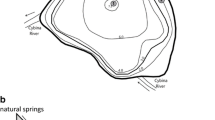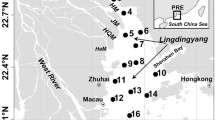Abstract
Based on hydrological, hydrochemical and hydrobiological studies made during 2010–2016 and considering the previous data, we discuss seasonal and interannual changes in the content of total and inorganic phosphorus on the Russian territory of the Selenga river. The study period is characterized by low hydraulicity of the river (especially in 2015) and short–lasting summer floods in 2012 and 2013. Concentrations of inorganic phosphorus varied within 0–174 μg/L, and total phosphorus varied from 28 to346 μg/L. Their maximum values are largely due to phosphorous inputs with sewage from economic facilities. It is shown that inputs of pollutants from the Mongolian territory are responsible for the increased phosphorus content levels in the river (as far as the river mouth) on the Russian territory, with corresponding local increases in phosphorus concentrations content manifesting themselves under the influence of anthropogenic factors. The lowest concentrations of inorganic phosphorus are recorded in the spring–autumn period with low hydraulicity and the mass development of the phytoplankton. During floods, high concentrations of inorganic phosphorus are recorded with an increase in flow velocity as well as with input of suspended solids and pollutants from the catchment area accompanied by a dramatic decrease of algal growth. In conditions of a long–lasting low water level since 1996, the Selenga has shown a tendency for a decrease in average annual concentrations of inorganic phosphorus and for an increase in the content level of its organic compounds. It is shown that the inputs of both inorganic and total phosphorus by the river are governed by changes in the water runoff. During the 2010–2016 low water level, the output of inorganic phosphorus with the waters of the Selenga river decreased by a factor of 1.9–4.5, whereas the total phosphorus concentration increased by a factor of 2.9. The structure of phosphorus output to the lake has changed, i.e. outputs of inorganic and organic phosphorus decreased and increased, respectively.
Similar content being viewed by others
References
Shimaraev, M.N. Kuimova, L.N. Sinyukovich, V.N. and Tsekhanovskii, V.V. Manifestation of Global Climatic Changes in Lake Baikal During the 20th Century, Dokl. Earth Sci., 2002, vol. 383A, issue 3, pp. 288–291.
Sinyukovich, V.N. Sizova, L.N. Shimaraev, M.N. and Kurbatova, N.N. Characteristics of Current Changes in Water Inflow into Lake Baikal, Geogr. Nat. Resour., 2013, vol. 34, issue 4, pp. 350–355.
Votintsev, K.K. Glazunov, I.V. and Tolmacheva, A.P. Hydrochemistry of the Rivers of the Lake Baikal Drainage Basin, Moscow: Nauka, 1965 [in Russian].
Bogdanov, V.T. Current Status of Seasonal and Interannual Variability in Chemical Flow of the Selenga River, Book of Abstracts for the IV All–Union Limnol. Meeting “Matter and Energy Cycle in Water Bodies. Hydrochemistry and Water Quality” (Listvenichnoe, 1977), Irkutsk, 1977, pp. 92–94 [in Russian].
Tarasova, E.N. and Meshcheryakova, A.I. Current Status of the Hydrochemical Regime of Lake Baikal, Novosibirsk: Nauka, 1992 [in Russian].
Sorokovikova, L.M. Sinyukovich, V.N. Khodzher, T.V. Golobokova, L.P. Bashenkhaeva, N.V. and Netsvetaeva, O.G. Input of Biogenic Elements and Organic Matter Into Lake Baikal With the River Waters and Atmospheric Precipitation, Meteorol. Gidrol., 2001, no. 4, pp. 78–86 [in Russian].
Popovskaya, G.I. and Kuz’mina, A.E. Long–Term Dynamics of the Phytoplankton of the Selenga River, Abstract Book for the III All–Union Conf. “Problems of Ecology of Cisbaikalia” (Sept. 5–10, 1988, Irkutsk), Irkutsk, 1988, part 2, p. 123 [in Russian].
Popovskaya, G.I. and Tashlykova, N.A. The Selenga River Delta–Natural Biofilter and Indicator of the Condition of Lake Baikal, A.K. Tulokhonov, Ed., Novosibirsk: SO RAN, 2008, pp. 167–181 [in Russian].
Tomberg, I.V. Transformation of Chemical Composition of River Waters in the Zone of Mixing With Lake Waters (Exemplified by the Main Tributaries of Baikal), Extended Abstract of Cand. Sci. (Geogr.) Dissertation, Irkutsk, 2008 [in Russian].
Sorokovikova, L.M. Popovskaya, G.I. Tomberg, I.V. and Bashenkhaeva, N.V. Space and Time Variation in Concentrations of Biogenic and Organic Matter and Phytoplankton in the Water of the Selenga River and Its Delta Branches, Water Resour., 2009, vol. 36, issue 4, pp. 443–452.
Manual on Chemical Analysis of Surface Waters of Land, L.V. Boeva, Ed., Rostov–on–Don: NIK, 2009, part 1 [in Russian].
Baram, G.I. Vereshchagin, A.L. and Golobokova, L.P. Use of <icrocolumn High–Performance Liquid Chromatography With UV Detection for Determining Anions in Environmental Objects, Zh. Anal. Khim., 1999, vol. 54, no. 9, pp. 962–965 [in Russian].
Wetzel, R.G. and Likens, G.E. Limnological Analyses, 2nd Ed., New York: Springer Science+Business Media, 1991.
Kozhova, O.M. and Mel’nik, N.G. Instructions on Processing Plankton Samples by the Counting Method, Irkutsk: Irk. Univ., 1978 [in Russian].
Shimarayev, M.N. and Starygina, L.N. Lake Baikal: Zonal Atmospheric Circulation and Hydrological Processes (1968–2007), Geogr. Nat. Resour., vol. 31, issue 3, pp. 245–250.
Sorokovikova, L.N. Tomberg, I.V. and Bashenkhaeva, N.V. Chemical Composition of the Waters of the Selenga River and Its Delta Branches, in The Selenga River Delta–Natural Biofilter and Indicator of the Condition of Lake Baikal, A.K. Tulokhonov, Ed., Novosibirsk: SO RAN, 2008, pp. 88–101 [in Russian].
Sinyukovich, V.N. Sorokovikova, L.M. Tomberg, I.V. and Tulokhonov, A.K. Climate Changes and the Selenga River Chemical Flow, Dokl. Earth Sci., vol. 433, issue 2, pp. 1127–1131.
Sorokovikova, L.M. Tulokhonov, A.K. Sinyukovich, V.N. Popovskaya, G.I. Nikulina, I.G. Tomberg, I.V. Bashenkhaeva, N.V. Maksimenko, S.Yu., Pogodaeva, T.V. Il’icheva, E.A. and Nekrasov, A.V. Water Quality in the Selenga Delta, Geogr. Prir. Resur., 2005, no. 1, pp. 73–80 [in Russian].
Gashkina, N.A. Moiseyenko, T.I. and Kremleva, T.A. Aspects of Organic Matter and Nutrient Distribution in Small Lakes and Limitation of Their Trophicity in the European Territory of Russia and in Western Siberia, Tyumen State Univ. Herald, 2012, no. 12, pp. 14–22.
Sorokovikova, L.M. Popovskaya, G.I. Tomberg, I.V. Sinyukovich, V.N. Kravchenko, O.S. Marinaite, I.I. Bashenkhaeva, N.V. and Khodzher, T.V. The Selenga River Water Quality on the Border With Mongolia at the Beginning of the 21st Century, Russian Meteorol. Hydrol., 2013, vol. 38, issue 2, pp. 126–133.
Author information
Authors and Affiliations
Corresponding author
Additional information
Original Russian Text © L.M. Sorokovikova, I.V. Tomberg, V.N. Sinyukovich, E.V. Molozhnikov, E.V. Eletskaya, 2018, published in Geografiya i Prirodnye Resursy, 2018, Vol. 39, No. 4, pp. 88–94.
Rights and permissions
About this article
Cite this article
Sorokovikova, L.M., Tomberg, I.V., Sinyukovich, V.N. et al. Phosphorus in the Selenga River Water and Its Input to Lake Baikal in Conditions of Low Hydraulicity. Geogr. Nat. Resour. 39, 343–348 (2018). https://doi.org/10.1134/S1875372818040078
Received:
Published:
Issue Date:
DOI: https://doi.org/10.1134/S1875372818040078




